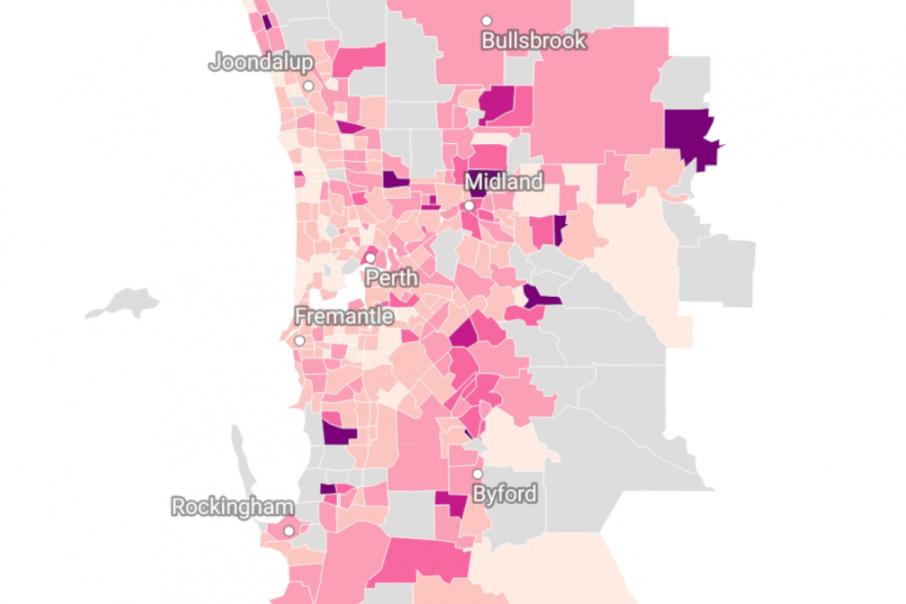As many as 300 Western Australians could fall behind on mortgage payments for each 25 basis point rise in interest rates. Click through for Perth’s mortgage map.


As many as 300 Western Australians could fall behind on mortgage payments for each 25 basis point rise in interest rates, according to estimates by Illion head of modelling Barrett Hasseldine.
Data from the credit agency (see map below) has shed light on which Perth suburbs have the highest rates of mortgage arrears, where homeowners are more than 30 days behind on payments.
Malaga in Perth’s inner north is top of the pile, with 2.9 per cent of borrowers behind on their home loans.
Mahogany Creek (2.8 per cent) and Middle Swan (2.6 per cent) - both northeast of the CBD - are also high on the list, as was Merriwa (2.6 per cent), near Wanneroo.
Outside the metro area, Coolgardie (4.7 per cent), South Boulder (3.9 per cent) and Kambalda East (3.7 per cent) in the Goldfields have even higher rates of arrears, although those locations have smaller pools of mortgages making data less reliable.
Western Australia has a higher level of borrowers in arrears than the national average, and the regions have been hit worse than metro Perth, Illion data shows.
Mr Hasseldine said he expected loan delinquencies would worsen before they show signs of improvement.
“The primary driver of rising home loan delinquencies is that costs have risen materially more than wages have,” Mr Hasseldine told Business News.
In Perth, inflation was 8.3 per cent in 2022, higher than almost any other capital city.
Mr Hasseldine said households in mid-to-lower socio economic regions were being hit harder, as were those who refinance to maximum capacity during the pandemic.
Banks generally assess mortgages with a 3 per cent buffer, he said, but the Reserve Bank of Australia has raised the official cash rate by 3.25 percentage points.
The expiry of fixed loans will create further pressure.
Borrowers usually prioritise mortgages and phone bills most when it comes to repayments, according to Illion research, which means mortgage arrears only show part of the financial squeeze gripping households.
So it’s not just the borrowers who are falling behind on their payments who are under pressure from rising rates.
Families across the state are needing to cut back on spending to keep paying off their mortgages.
One recent homebuyer (preferring to remain anonymous), spoke to Business News about their mortgage after buying a house about a year ago in Morley.
An artist in her mid-thirties, she told Business News that her family had compared the cost of renting, and felt the opportunity to secure financing from a bank would not readily come by again.
But as her and her partner are artists not on a regular salary, they could not secure a fixed rate mortgage.
“We’ve got a toddler, it’s huge,” she said.
“We’re definitely under pressure.”
The family had a list of things they could cut back on, although they were not big spenders to begin with.
However, she said she was fortunate not to be needing a rental in the current market.
“It could be worse,” she said.
“It’s not pushed to the extreme but not great.”
Expectations of as many as four rate rises this year were troubling, however.
“The worry is if it keeps going,” she said.
“(Four) would be huge… we’re not high earners.”
Research by ratings agency Moody’s reported by Business News in October last year pointed to Perth’s inner north as a hotspot for mortgage arrears.
That used data from Residential Mortgage-Backed Securities, which are financial products derived from home loans.
Moody's found 4.2 per cent of RMBS mortgages in Ballajura were 30 days in arrears as at May 2022, before the Reserve Bank embarked on a record tightening cycle.
Alexander Heights and Burns Beach both had rates slightly higher than 3 per cent.
How are rising rates impacting WA homeowners? Read more in the 13th February edition of Business News.






